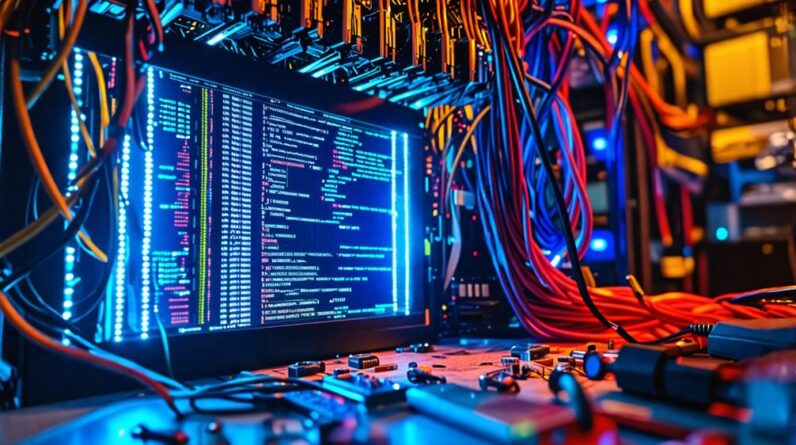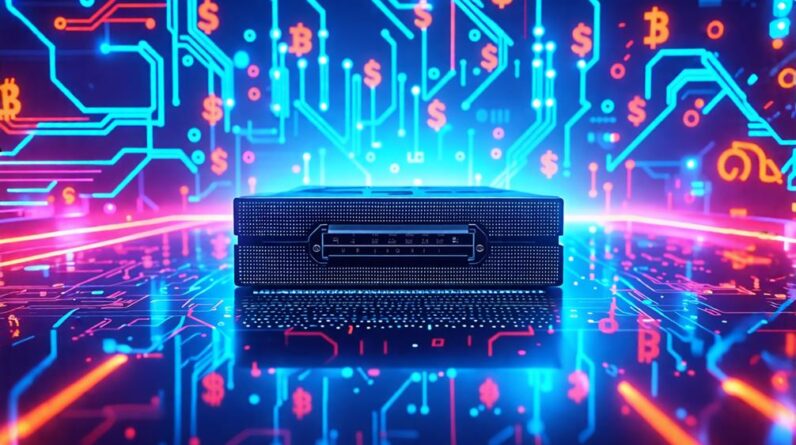
Crypto mining is a rewarding venture where you validate transactions and earn cryptocurrency. Start by choosing a mining method: ASIC mining is efficient for Bitcoin, while GPU mining works well for altcoins. You'll need essential hardware, like ASIC miners or high-performance graphics cards, and a secure wallet to store your earnings. Joining a mining pool can increase your chances of success and provide consistent rewards. Monitor your activities and track costs closely to manage profits effectively. As you explore further, you'll uncover practical tips and strategies to enhance your mining experience.
Table of Contents
Understanding Cryptocurrency Mining
Cryptocurrency mining is the process where you validate transactions on a blockchain by solving complex puzzles, earning rewards in return. This innovative method not only secures the network but also incentivizes your participation with exciting cryptocurrency rewards. When you engage in mining, you compete against others to create a valid hash using algorithms like SHA-256, particularly in PoW (Proof-of-Work) systems such as Bitcoin and Litecoin.
The average block creation time for Bitcoin is around 10 minutes, and as of February 2023, there are only 2.1 million bitcoins left to be mined. Successfully mining a block currently nets you 6.25 BTC, making the race worthwhile. However, the challenge intensifies as mining difficulty increases over time, requiring you to invest in more powerful hardware to stay competitive.
Understanding the mechanics of cryptocurrency mining is essential for anyone looking to immerse themselves in this dynamic landscape. As you explore this innovative field, you'll discover not just the potential for profit, but also how your efforts contribute to the overall security and functionality of the blockchain.
Types of Mining Methods
When exploring mining methods, you'll find that ASIC mining offers incredible efficiency but comes with a hefty price tag. On the other hand, joining a mining pool can boost your chances of earning rewards by collaborating with others. Each method has its own set of advantages, so it's crucial to evaluate what works best for your situation.
ASIC Mining Advantages
ASIC mining offers distinct advantages over other methods by providing unparalleled efficiency and higher hash rates, making it the preferred choice for serious miners targeting cryptocurrencies like Bitcoin. With ASIC miners, you can expect to achieve hash rates that GPU and CPU mining simply can't match, which greatly boosts your mining profitability.
Here's a quick comparison of mining methods:
| Mining Method | Hash Rate |
|---|---|
| ASIC | Up to 110 TH/s |
| GPU | 30-60 MH/s |
| CPU | 1-5 KH/s |
| FPGA | 100-500 MH/s |
Investing in ASIC mining equipment, like the Antminer S19j Pro, means you're solving complex problems faster and enhancing your chances of earning block rewards. While the initial costs can be high, the efficiency of ASIC miners often results in better overall energy usage and lower operational costs, especially in competitive environments.
When you're serious about mining, understanding the advantages of ASIC technology is essential. It can lead you to not only maximize your returns but also embrace the innovative future of cryptocurrency mining.
Mining Pool Collaboration
Mining pools offer a collaborative approach that greatly enhances your chances of successfully mining blocks by combining resources with other miners. If you're a beginner, joining a mining pool can be an innovative way to improve your hashing power without the need for an extensive hardware investment. By pooling your efforts, you'll benefit from more consistent rewards, which is essential when starting out.
Typically, you'll pay a small fee—usually between 1% to 3%—for the privilege of joining a mining pool. However, this cost is often outweighed by the more reliable payouts you'll receive compared to mining solo. Popular mining pools like FoundryUSA and BTC.com show how collaboration can greatly influence mining success, with FoundryUSA controlling about 30% of the Bitcoin network's hash rate.
In a mining pool, your rewards are distributed based on your contributed hashing power, promoting teamwork and encouraging participation. With effective communication and monitoring tools available through mining pool dashboards, you can easily track your contributions and earnings, allowing you to make informed decisions about your mining strategies. Embrace the power of collaboration to maximize your cryptocurrency earnings!
Essential Mining Hardware

To effectively mine cryptocurrencies, you'll need the right hardware tailored to your chosen coin's algorithm and performance requirements. Depending on your focus, different setups can enhance your mining strategy.
- ASIC Miners: For Bitcoin, consider devices like the Antminer S19j Pro, which boasts a remarkable hash rate of up to 110 TH/s. While it comes with a higher price tag of around $4,500, its efficiency can justify the investment.
- Scrypt ASIC Miners: If you're interested in cryptocurrencies like Litecoin or Dogecoin, you'll need specialized Scrypt-based ASIC miners, as traditional mining rigs won't deliver ideal results.
- GPU Mining Rigs: For altcoins, a GPU mining rig featuring high-performance graphics cards like the Nvidia RTX 3090 can be a great choice. Initial costs range from $1,000 to $3,000, depending on how many GPUs you decide to use.
- Power Supply Unit (PSU): Confirm your hardware is paired with a PSU rated for at least 80 Plus Gold efficiency to minimize energy costs and maximize performance.
Investing in the right hardware will pave your way to successful mining!
Setting Up Your Wallet
Choosing a secure wallet is vital for safely storing the cryptocurrency you mine. You have two main options: hot wallets, which are online and easily accessible, and cold wallets, which are offline and provide enhanced security. If you value convenience, a hot wallet like Exodus or Electrum might be right for you. For superior security, consider a hardware wallet like Ledger or Trezor.
When setting up your crypto wallet, start by generating a strong password and enabling two-factor authentication. This adds an extra layer of protection against unauthorized access. Don't forget to back up your wallet's recovery phrase or private keys securely; losing this information could result in a permanent loss of your funds.
Regularly updating your wallet software is also essential. These updates come with security enhancements and new features, ensuring your assets remain safe from emerging threats. By prioritizing these steps, you'll create a secure environment for your mined cryptocurrency, giving you peace of mind as you dive deeper into the world of crypto mining. Remember, the security of your funds is only as strong as the measures you take to protect them.
Choosing a Mining Pool

Finding the right mining pool can greatly boost your chances of earning rewards by pooling your resources with other miners. To guarantee you choose the best option, consider the following factors:
- Fees: Look for pools with fees ranging from 1% to 3% of your earnings. Higher fees can eat into your profits.
- Payout Structure: Understand the pool's payout methods, like Pay Per Share (PPS) or Pay Per Last N Shares (PPLNS), as these can affect how and when you receive rewards.
- Reputation and History: Opt for pools with a solid reputation and consistent payout history. Larger pools, such as FoundryUSA and BTC.com, dominate the Bitcoin mining landscape and provide reliable hashing power.
- Supported Cryptocurrencies: Make certain the mining pool supports the cryptocurrency you want to mine. Different pools specialize in specific coins, and the rewards can vary based on network conditions and difficulty levels.
Downloading Mining Software
When you're ready to start mining, selecting compatible software is essential for your hardware and the cryptocurrency you want to mine. You'll need to go through the installation process carefully, ensuring you download from trustworthy sources. Once installed, configuring and optimizing your software will help you get the most out of your mining efforts.
Choosing Compatible Software
Downloading mining software that matches your hardware is crucial for optimizing performance and maximizing your profits. When you're using ASIC miners for Bitcoin or Scrypt-based miners for Litecoin and Dogecoin, verifying compatibility is key. Here's how to choose the right mining software:
- Identify Your Hardware: Know whether you're using ASIC miners or other types of compatible hardware to choose the right software.
- Research Options: Popular mining software like CGMiner and BFGMiner offer robust features, supporting various cryptocurrencies and providing essential monitoring tools.
- Verify Sources: Always download from official sources or reputable developers to safeguard against malware or hacking risks.
- Stay Updated: Regularly check for software updates to maintain security and verify your setup remains compatible with network changes.
Installation Process Overview
To kick off your mining journey, select and download the right mining software that aligns with your hardware and cryptocurrency choice. Popular options include CGMiner, BFGMiner, and BitMinter. Make certain you download the software from the official website or a trusted source to protect your system from malware and guarantee your security.
Once you've got the mining software downloaded, it's time for installing. Follow the on-screen instructions for a smooth installation process. Afterward, you'll need to focus on configuration. This step is fundamental, as you'll enter your mining pool credentials and wallet address to guarantee your earnings are directed correctly.
To streamline your experience, set your mining software to automatically start mining upon launch, so you can hit the ground running every time. Keeping your mining software updated is also vital; regularly check for the latest versions to maintain peak performance and safeguard against vulnerabilities.
Configuration and Optimization Tips
After successfully installing your mining software, the next step involves configuring and refining it for maximum efficiency. Proper configuration can greatly enhance your mining experience and output. Here are some key tips to get you started:
- Check Compatibility: Verify your mining software is compatible with your hardware—be it ASIC, GPU, or CPU. This alignment is essential for peak performance.
- Choose the Right Software: Popular options like CGMiner, BFGMiner, and EasyMiner cater to various operating systems and offer essential features. Pick one that suits your needs.
- Download from Reputable Sources: Always acquire your mining software from official websites to avoid malware and security issues. This step is critical for protecting your investment.
- Configure Settings: Carefully adjust settings such as pool address, worker credentials, and hardware parameters. This configuration maximizes your hashing power and minimizes downtime.
Remember to regularly update your mining software to leverage performance improvements, bug fixes, and enhanced security features. By prioritizing configuration and refinement, you'll set yourself up for a successful mining journey.
Configuring Mining Settings

Configuring mining settings is vital for guaranteeing your hardware works efficiently and connects seamlessly to the mining pool. First, you need to choose the right mining software compatible with your hardware. If you're using ASIC miners for Bitcoin, make sure the software supports that specific model. Once you've installed the software, accurately input the mining pool URL and your worker credentials to establish a connection.
Next, consider adjusting the overclocking settings of your ASIC miners. This can enhance performance and increase your ability to mine cryptocurrency effectively. However, keep a close eye on temperatures to prevent overheating, which could lead to hardware damage. It's also essential to regularly update your mining software. Doing this will provide you with the latest features, security patches, and performance improvements, all of which can greatly boost your mining efficiency.
Lastly, explore advanced settings within the mining software, such as auto-restart features. These settings can guarantee continuous operation, minimizing downtime due to hardware or network issues. With these configurations in place, you're well on your way to maximizing your mining efforts.
Monitoring Your Mining Activity
Monitoring your mining activity is key to understanding how well your setup is performing and making informed adjustments for better results. By utilizing the right tools and strategies, you can maximize your profits and maintain an efficient operation.
Here are four essential steps to effectively monitor your mining activity:
- Implement mining software: Use tools like CGMiner or BFGMiner that provide real-time monitoring of hash rates, temperatures, and performance metrics. This helps you optimize your mining efficiency.
- Leverage mining pool dashboards: Platforms like Slushpool or F2Pool offer detailed dashboards where you can track your earnings, shares submitted, and your overall contribution to the pool's hash rate.
- Check power consumption regularly: Keep an eye on your mining rig's power usage to confirm it stays within budget. This prevents high electricity costs from eroding your profits.
- Set alerts for critical changes: Establish notifications for significant shifts in mining difficulty or cryptocurrency prices. This proactive approach allows you to adjust your mining strategy as needed, keeping your operation agile and profitable.
Managing Costs and Profits

When you're mining cryptocurrencies, keeping a close eye on your electricity expenses is essential to your profit margins. You'll want to explore methods for calculating profitability to guarantee your investment pays off. Understanding these costs and calculations can help you make smarter decisions in this ever-changing landscape.
Electricity Expense Analysis
Electricity expenses can drain your profits in cryptocurrency mining, so analyzing and optimizing your energy consumption is essential. High electricity costs can account for 30-50% of your operational expenses, impacting your bottom line considerably. To manage these costs effectively, consider the following strategies:
- Choose Energy-Efficient Hardware: Opt for ASIC miners like the Bitmain S19 XP, which offers a high hash rate of 140 TH/s while consuming only 3010W. This can enhance efficiency and lower electricity bills.
- Evaluate Your Location: Mining in regions with lower electricity rates can dramatically improve your profitability. Areas in Quebec or parts of China offer rates as low as $0.03 per kWh.
- Monitor Your Usage: Regularly tracking your electricity consumption helps identify patterns, enabling you to make informed decisions about your mining operations.
- Explore Renewable Energy Sources: Incorporating solar panels or other renewable energy solutions can reduce reliance on traditional electricity sources, cutting costs further.
Profitability Calculation Methods
To determine your mining profitability, you'll need to account for factors like cryptocurrency prices, mining difficulty, and block rewards. For instance, Bitcoin currently offers 6.25 BTC per block. Here's a simple breakdown to visualize your potential profits:
| Factor | Example Value | Impact on Profitability |
|---|---|---|
| Cryptocurrency Price | $40,000 per BTC | Directly increases profit |
| Mining Difficulty | Medium (varies) | Higher difficulty lowers rewards |
| Electricity Costs | $0.10 per kWh | Significant daily expense |
| Daily Power Cost | $7.80 (3250 watts) | Reduces net earnings |
| Mining Rewards | Varies with pool size | More frequent payouts in pools |
Using profitability calculators can help you estimate your expected earnings based on your hardware's hash rate and power consumption. Don't underestimate electricity costs—they can eat into your profits. Regularly monitor market trends, as cryptocurrency prices fluctuate rapidly, impacting your bottom line. Finally, consider joining mining pools to diversify your efforts. This can improve your chances of consistent mining rewards and provide a more stable income stream.
Security Best Practices
Securing your crypto mining operations is essential, and implementing two-factor authentication (2FA) on all your accounts is a great first step. This added layer of security helps protect against unauthorized access. To further safeguard your assets, consider these key security measures:
- Utilize hardware wallets: Store your mined cryptocurrencies in hardware wallets, providing exceptional security by keeping your assets offline.
- Regularly update software: Keep your mining software and wallets updated to shield against vulnerabilities and potential exploits.
- Research mining pools: Before joining a mining pool, conduct thorough research to confirm they have a strong reputation and robust security measures in place.
- Maintain offsite backups: Regularly back up critical data, including mining configurations and wallet recovery phrases, to prevent loss due to hardware failure or cyberattacks.
Conclusion
Getting started with crypto mining can seem intimidating, but by following these steps, you'll be well on your way to diving into the world of cryptocurrency. Remember to stay informed about the latest trends, continually optimize your setup, and prioritize security. As you navigate the ups and downs of mining, keep a close eye on your costs and profits to maximize your success. With patience and persistence, you'll find your place in this exciting digital frontier.







